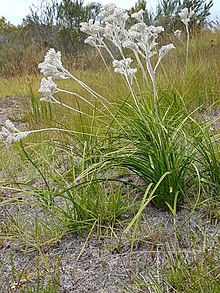Lanaria is a monotypic genusofflowering plants containing a single species, Lanaria lanata, endemic to the southern coast of South Africa where it is associated with the fynbos belt.[4][5][6] Lanaria lanata is commonly known as Cape edelweissorlambtails. The genus is placed in the monotypic family Lanariaceae,[2] a family only recently recognized by taxonomists. The APG IV system of 2016 (unchanged from the 1998, the 2003 and 2009 versions) does recognize this family.[7][3]
| Lanaria | |
|---|---|

| |

| |
| Scientific classification | |
| Kingdom: | Plantae |
| Clade: | Tracheophytes |
| Clade: | Angiosperms |
| Clade: | Monocots |
| Order: | Asparagales |
| Family: | Lanariaceae H.Huber ex. R.Dahlgren & A.E.van Wyk[3] |
| Genus: | Lanaria Aiton[2] |
| Species: |
L. lanata
|
| Binomial name | |
| Lanaria lanata (L.) T.Durand & Schinz[1] | |
| Distribution map | |
| Synonyms | |
| |
This species occurs on clay and sandstone soils throughout its distribution range. The stiff, ribbed leaves arise from a woody rootstock and are evergreen, channelled, and finely serrate along the margins. The densely woolly, white heads enclose mauve flowers and are peculiar to the species. Flowering is profuse following fires.
Both 'lanaria' and 'lanata' are derived from 'lana', Latin for 'wool'.
The Cape Floristic Region in South Africa is comparatively rich in endemic flowering-plant families. Five families of angiosperms (Penaeaceae, Roridulaceae, Geissolomataceae, Grubbiaceae, and Lanariaceae) are endemic to that region ...